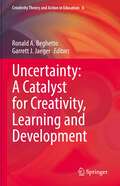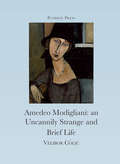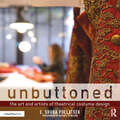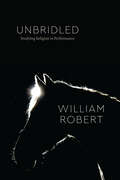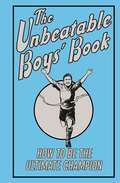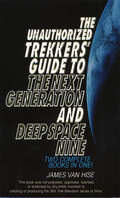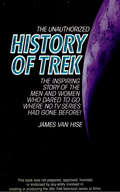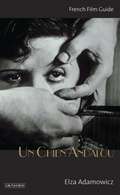- Table View
- List View
Uncertainty for Safe Utilization of Machine Learning in Medical Imaging, and Graphs in Biomedical Image Analysis: Second International Workshop, UNSURE 2020, and Third International Workshop, GRAIL 2020, Held in Conjunction with MICCAI 2020, Lima, Peru, October 8, 2020, Proceedings (Lecture Notes in Computer Science #12443)
by Tal Arbel Enzo Ferrante Sarah Parisot Aristeidis Sotiras Adrian Dalca Bartlomiej Papiez William M. Wells Ryutaro Tanno Carole H. Sudre Hamid Fehri Christian F. Baumgartner Koen Van LeemputThis book constitutes the refereed proceedings of the Second International Workshop on Uncertainty for Safe Utilization of Machine Learning in Medical Imaging, UNSURE 2020, and the Third International Workshop on Graphs in Biomedical Image Analysis, GRAIL 2020, held in conjunction with MICCAI 2020, in Lima, Peru, in October 2020. The workshops were held virtually due to the COVID-19 pandemic.For UNSURE 2020, 10 papers from 18 submissions were accepted for publication. They focus on developing awareness and encouraging research in the field of uncertainty modelling to enable safe implementation of machine learning tools in the clinical world. GRAIL 2020 accepted 10 papers from the 12 submissions received. The workshop aims to bring together scientists that use and develop graph-based models for the analysis of biomedical images and to encourage the exploration of graph-based models for difficult clinical problems within a variety of biomedical imaging contexts.
Uncertainty for Safe Utilization of Machine Learning in Medical Imaging and Clinical Image-Based Procedures: First International Workshop, UNSURE 2019, and 8th International Workshop, CLIP 2019, Held in Conjunction with MICCAI 2019, Shenzhen, China, October 17, 2019, Proceedings (Lecture Notes in Computer Science #11840)
by Hayit Greenspan Ryutaro Tanno Marius Erdt Tal Arbel Christian Baumgartner Adrian Dalca Carole H. Sudre William M. Wells Klaus Drechsler Marius George Linguraru Cristina Oyarzun Laura Raj Shekhar Stefan Wesarg Miguel Ángel González BallesterThis book constitutes the refereed proceedings of the First International Workshop on Uncertainty for Safe Utilization of Machine Learning in Medical Imaging, UNSURE 2019, and the 8th International Workshop on Clinical Image-Based Procedures, CLIP 2019, held in conjunction with MICCAI 2019, in Shenzhen, China, in October 2019. For UNSURE 2019, 8 papers from 15 submissions were accepted for publication. They focus on developing awareness and encouraging research in the field of uncertainty modelling to enable safe implementation of machine learning tools in the clinical world. CLIP 2019 accepted 11 papers from the 15 submissions received. The workshops provides a forum for work centred on specific clinical applications, including techniques and procedures based on comprehensive clinical image and other data.
Uncertainty: A Catalyst for Creativity, Learning and Development (Creativity Theory and Action in Education #6)
by Ronald A. Beghetto Garrett J. JaegerThis edited volume brings together a group of international researchers and theorists from various intellectual and analytic traditions to explore the role uncertainty plays in creativity, learning, and development. Contributors to this volume draw on existing programs of research as well as introduce new and even speculative directions for research, theory and practice.Learning and life are filled with uncertainty. Although the experience of uncertainty can cause emotional discomfort or cognitive rigidity, uncertainty serves as a catalyst and condition for change. In this way, uncertainty represents a core facet in the interrelationship among creativity, learning, and development. Considerations for both the benefits and potential costs of uncertainty will be addressed in this volume with an aim of understanding how uncertainty can be better understood in light of creativity, learning, and development. Taken together this volume stands to contribute to our collective understanding of the role that uncertainty plays in learning and life and highlights how conceptualizing and studying uncertainty in new ways can promote positive and lasting change.
Uncertainty and Possibility: New Approaches to Future Making in Design Anthropology
by Yoko Akama Sarah Pink Shanti SumartojoUncertainty and possibility are emerging as both theoretical concepts and fields of empirical investigation, as scholars and practitioners seek new creative, hopeful and speculative modes of understanding and intervening in a world of crisis.This book offers new perspectives on the central issues of uncertainty and possibility, and identifies new research methods which take advantage of disruptive and experimental techniques. Advancing a practical agenda for future making, it reveals how uncertainty can be engaged as a generative ‘technology’ for understanding, researching and intervening in the world. Drawing on key themes in creative methodologies, such as making, essaying, inhabiting and attuning, chapters explore contemporary sites of practice. The book looks at maker spaces and technology design, the imaginaries of architectural design, the temporalities of built cultural heritage, and interdisciplinary making and performing. Based on the authors' own academic work and their applied research with a range of different organizations, Uncertainty and Possibility outlines new opportunities for research and intervention. It is essential reading for students, scholars and practitioners in design anthropology and human-centred design.
Uncertainty and Possibility: New Approaches to Future Making in Design Anthropology (Criminal Practice Ser.)
by Yoko Akama Sarah Pink Shanti SumartojoUncertainty and possibility are emerging as both theoretical concepts and fields of empirical investigation, as scholars and practitioners seek new creative, hopeful and speculative modes of understanding and intervening in a world of crisis.This book offers new perspectives on the central issues of uncertainty and possibility, and identifies new research methods which take advantage of disruptive and experimental techniques. Advancing a practical agenda for future making, it reveals how uncertainty can be engaged as a generative ‘technology’ for understanding, researching and intervening in the world. Drawing on key themes in creative methodologies, such as making, essaying, inhabiting and attuning, chapters explore contemporary sites of practice. The book looks at maker spaces and technology design, the imaginaries of architectural design, the temporalities of built cultural heritage, and interdisciplinary making and performing. Based on the authors' own academic work and their applied research with a range of different organizations, Uncertainty and Possibility outlines new opportunities for research and intervention. It is essential reading for students, scholars and practitioners in design anthropology and human-centred design.
Uncertain Projective Geometry: Statistical Reasoning for Polyhedral Object Reconstruction (Lecture Notes in Computer Science #3008)
by Stephan HeuelAlgebraic projective geometry, with its multilinear relations and its embedding into Grassmann-Cayley algebra, has become the basic representation of multiple view geometry, resulting in deep insights into the algebraic structure of geometric relations, as well as in efficient and versatile algorithms for computer vision and image analysis. This book provides a coherent integration of algebraic projective geometry and spatial reasoning under uncertainty with applications in computer vision. Beyond systematically introducing the theoretical foundations from geometry and statistics and clear rules for performing geometric reasoning under uncertainty, the author provides a collection of detailed algorithms. The book addresses researchers and advanced students interested in algebraic projective geometry for image analysis, in statistical representation of objects and transformations, or in generic tools for testing and estimating within the context of geometric multiple-view analysis.
Uncertain Images: Museums And The Work Of Photographs
by Elizabeth Edwards Sigrid LienAlmost all museums hold photographs in their collections, and museum professionals and their audiences engage with photographs in a myriad of ways. Yet despite some three decades of critical museology and photographic theory, and an extensive debate on the politics of representation, outside art museums, almost no critical attention has been given specifically to the roles, purposes and lives of these photographs within museums. This book brings into focus the ubiquitous yet entirely unconsidered work that photographs are put to in museums. The authors' argument is that there is an economy of photographs in museums which is integral to the processes of the museum, and integral to the understanding of museums. The international contributors, drawn from curators and academics, reflect a range of visual and museological expertise. After an introduction setting out the range of questions and problems, the first part addresses broad curatorial strategies and ways of thinking about photographs in museums. Shifting the emphasis from curatorial practices and anxieties to the space of the gallery, this is followed by a series of case studies of exhibitionary practices and the museum strategies that support them. The third section focuses on the role of photographs in the museum articulation of ’difficult histories’. A final section addresses photograph collections in a digital environment. New technologies and new media have transformed the management, address and purposing in photographs in museums, from cataloguing practices to streaming on social media. These growing practices challenge both traditional hierarchies of knowledge in museums and the location of authority about photographs. The volume emerges from PhotoCLEC, a HERA funded project on museums and the photographic legacy of the colonial past in a postcolonial and multicultural Europe.
Uncertain Images: Museums And The Work Of Photographs
by Elizabeth Edwards Sigrid LienAlmost all museums hold photographs in their collections, and museum professionals and their audiences engage with photographs in a myriad of ways. Yet despite some three decades of critical museology and photographic theory, and an extensive debate on the politics of representation, outside art museums, almost no critical attention has been given specifically to the roles, purposes and lives of these photographs within museums. This book brings into focus the ubiquitous yet entirely unconsidered work that photographs are put to in museums. The authors' argument is that there is an economy of photographs in museums which is integral to the processes of the museum, and integral to the understanding of museums. The international contributors, drawn from curators and academics, reflect a range of visual and museological expertise. After an introduction setting out the range of questions and problems, the first part addresses broad curatorial strategies and ways of thinking about photographs in museums. Shifting the emphasis from curatorial practices and anxieties to the space of the gallery, this is followed by a series of case studies of exhibitionary practices and the museum strategies that support them. The third section focuses on the role of photographs in the museum articulation of ’difficult histories’. A final section addresses photograph collections in a digital environment. New technologies and new media have transformed the management, address and purposing in photographs in museums, from cataloguing practices to streaming on social media. These growing practices challenge both traditional hierarchies of knowledge in museums and the location of authority about photographs. The volume emerges from PhotoCLEC, a HERA funded project on museums and the photographic legacy of the colonial past in a postcolonial and multicultural Europe.
The Uncapturable: The Fleeting Art of Theatre (Theatre Makers)
by Rubén SzuchmacherThe Uncapturable is a wide-ranging reflection on the art of the mise en scène from the perspective of leading Argentinian theatre director Rubén Szuchmacher. It offers a timely and concise, though comprehensive, survey of the role and responsibility of the theatre director from the earliest times to the twenty-first century. Szuchmacher defines theatre as the confluence of four art forms - architecture, visual art, sound and literature - whose works only truly exist in the moment of encounter with an audience. He argues that, by taking full account of these four art forms, analysing them in detail and engaging thoughtfully with the many specialists who come together to bring a mise en scène into being, the director of today can still create work that innovates and inspires. The Uncapturable is as valuable to the apprentice director emerging from their training as it is to the veteran in need of fresh reflection. Szuchmacher draws on the unique learnings gleaned from working in Argentina, be it the impact on theatre of politics, the need for inventiveness in times of hardship, the phenomenon of Argentine 'circus theatre' or the adaptation of literary giants such as Borges, affording the Anglophone reader an alternative perspective on the ideas of theatre we often take for granted.Szuchmacher offers a unique blend of global knowledge, historical awareness and a pragmatic, resourceful and creative approach from a theatre artist working in Latin American through decades of change. The book is translated from the Spanish by William Gregory.
The Uncapturable: The Fleeting Art of Theatre (Theatre Makers)
by Rubén SzuchmacherThe Uncapturable is a wide-ranging reflection on the art of the mise en scène from the perspective of leading Argentinian theatre director Rubén Szuchmacher. It offers a timely and concise, though comprehensive, survey of the role and responsibility of the theatre director from the earliest times to the twenty-first century. Szuchmacher defines theatre as the confluence of four art forms - architecture, visual art, sound and literature - whose works only truly exist in the moment of encounter with an audience. He argues that, by taking full account of these four art forms, analysing them in detail and engaging thoughtfully with the many specialists who come together to bring a mise en scène into being, the director of today can still create work that innovates and inspires. The Uncapturable is as valuable to the apprentice director emerging from their training as it is to the veteran in need of fresh reflection. Szuchmacher draws on the unique learnings gleaned from working in Argentina, be it the impact on theatre of politics, the need for inventiveness in times of hardship, the phenomenon of Argentine 'circus theatre' or the adaptation of literary giants such as Borges, affording the Anglophone reader an alternative perspective on the ideas of theatre we often take for granted.Szuchmacher offers a unique blend of global knowledge, historical awareness and a pragmatic, resourceful and creative approach from a theatre artist working in Latin American through decades of change. The book is translated from the Spanish by William Gregory.
The Uncanny Valley in Games and Animation
by Angela TinwellAdvances in technology have enabled animators and video game designers to design increasingly realistic, human-like characters in animation and games. Although it was intended that this increased realism would allow viewers to appreciate the emotional state of characters, research has shown that audiences often have a negative reaction as the human
Uncanny Cinema: Agonies of the Viewing Experience
by Murray PomeranceMurray Pomerance's latest book explores an encyclopedic range of films and television shows to demonstrate the difficulty of conveying the experience of viewing cinema through words and the medium of text. From On the Waterfront to Marriage Story, Uncanny Cinema illuminates that words and writing are in perilous waters when applied to cinema, similar to ungestured talk. The book begins with this problem using Julian Jaynes's thoughts on vocality and imagination before delving into three exploratory 'movements' arranged to alternately challenge, inspire, and confound the reader to question if we know what we think we know or even see what we think we see. The viewer is faced with disturbances, ruptures, and surprises that occur during the viewing experience, which Pomerance analyzes to stretch the sense of what we do and do not (or, possibly, cannot) know, particularly as we think, talk, and write about cinema.
Uncanny Cinema: Agonies of the Viewing Experience
by Murray PomeranceMurray Pomerance's latest book explores an encyclopedic range of films and television shows to demonstrate the difficulty of conveying the experience of viewing cinema through words and the medium of text. From On the Waterfront to Marriage Story, Uncanny Cinema illuminates that words and writing are in perilous waters when applied to cinema, similar to ungestured talk. The book begins with this problem using Julian Jaynes's thoughts on vocality and imagination before delving into three exploratory 'movements' arranged to alternately challenge, inspire, and confound the reader to question if we know what we think we know or even see what we think we see. The viewer is faced with disturbances, ruptures, and surprises that occur during the viewing experience, which Pomerance analyzes to stretch the sense of what we do and do not (or, possibly, cannot) know, particularly as we think, talk, and write about cinema.
The Uncannily Strange and Brief Life of Amedeo Modigliani: An Uncannily Strange And Brief Life (Pushkin Blues Ser.)
by Velibor ColicThe life of the modernist painter Amedeo Modigliani (1884-1920) was chaotic and tragically brief. Spanning the last months of Modigliani's life, this evocative novel conjures up the strange workings of the painter's troubled - and often drug-fuelled - mind, and the manner in which his eccentricity expressed itself in his art. Colic's evocative novel captures the full essence of Modigliani's Bohemian lifestyle, and the colourful visitors who came and went through his Paris studio: among them his lover, Jeanne Hébuterne, and the prostitutes who occasionally modelled for him; and succeeds in conveying something of the intense artistic life of Paris in the first decades of the twentieth century.
Unbuttoned: The Art and Artists of Theatrical Costume Design
by Shura PollatsekUnbuttoned: The Art and Artists of Theatrical Costume Design documents the creative journey of costume creation from concept to performance. Each chapter provides an overview of the process, including designing and shopping; draping, cutting, dyeing, and painting; and beading, sewing, and creating embellishments and accessories. This book features interviews with practitioners from Broadway and regional theatres to opera and ballet companies, offering valuable insights into the costume design profession. Exceptional behind-the-scenes photography illustrates top costume designers and craftspeople at work, along with gorgeous costumes in progress.
Unbuttoned: The Art and Artists of Theatrical Costume Design
by Shura PollatsekUnbuttoned: The Art and Artists of Theatrical Costume Design documents the creative journey of costume creation from concept to performance. Each chapter provides an overview of the process, including designing and shopping; draping, cutting, dyeing, and painting; and beading, sewing, and creating embellishments and accessories. This book features interviews with practitioners from Broadway and regional theatres to opera and ballet companies, offering valuable insights into the costume design profession. Exceptional behind-the-scenes photography illustrates top costume designers and craftspeople at work, along with gorgeous costumes in progress.
Unbuilt Utopian Cities 1460 to 1900: Reconstructing their Architecture and Political Philosophy
by Tessa MorrisonBringing together ten utopian works that mark important points in the history and an evolution in social and political philosophies, this book not only reflects on the texts and their political philosophy and implications, but also, their architecture and how that architecture informs the political philosophy or social agenda that the author intended. Each of the ten authors expressed their theory through concepts of community and utopian architecture, but each featured an architectural solution at the centre of their social and political philosophy, as none of the cities were ever built, they have remained as utopian literature. Some of the works examined are very well-known, such as Tommaso Campanella’s Civitas Solis, while others such as Joseph Michael Gandy’s Designs for Cottages, are relatively obscure. However, even with the best known works, this volume offers new insights by focusing on the architecture of the cities and how that architecture represents the author’s political philosophy. It reconstructs the cities through a 3-D computer program, ArchiCAD, using Artlantis to render. Plans, sections, elevations and perspectives are presented for each of the cities. The ten cities are: Filarete - Sforzina; Albrecht Dürer - Fortified Utopia; Tommaso Campanella - The City of the Sun; Johann Valentin Andreae - Christianopolis; Joseph Michael Gandy - An Agricultural Village; Robert Owen - Villages of Unity and Cooperation; James Silk Buckingham - Victoria; Robert Pemberton - Queen Victoria Town; King Camp Gillette - Metropolis; and Bradford Peck - The World a Department Store. Each chapter considers the work in conjunction with contemporary thought, the political philosophy and the reconstruction of the city. Although these ten cities represent over 500 years of utopian and political thought, they are an interlinked thread that had been drawn from literature of the past and informed by contemporary thought and society. The book is structured in two parts:
Unbuilt Utopian Cities 1460 to 1900: Reconstructing Their Architecture And Political Philosophy
by Tessa MorrisonBringing together ten utopian works that mark important points in the history and an evolution in social and political philosophies, this book not only reflects on the texts and their political philosophy and implications, but also, their architecture and how that architecture informs the political philosophy or social agenda that the author intended. Each of the ten authors expressed their theory through concepts of community and utopian architecture, but each featured an architectural solution at the centre of their social and political philosophy, as none of the cities were ever built, they have remained as utopian literature. Some of the works examined are very well-known, such as Tommaso Campanella’s Civitas Solis, while others such as Joseph Michael Gandy’s Designs for Cottages, are relatively obscure. However, even with the best known works, this volume offers new insights by focusing on the architecture of the cities and how that architecture represents the author’s political philosophy. It reconstructs the cities through a 3-D computer program, ArchiCAD, using Artlantis to render. Plans, sections, elevations and perspectives are presented for each of the cities. The ten cities are: Filarete - Sforzina; Albrecht Dürer - Fortified Utopia; Tommaso Campanella - The City of the Sun; Johann Valentin Andreae - Christianopolis; Joseph Michael Gandy - An Agricultural Village; Robert Owen - Villages of Unity and Cooperation; James Silk Buckingham - Victoria; Robert Pemberton - Queen Victoria Town; King Camp Gillette - Metropolis; and Bradford Peck - The World a Department Store. Each chapter considers the work in conjunction with contemporary thought, the political philosophy and the reconstruction of the city. Although these ten cities represent over 500 years of utopian and political thought, they are an interlinked thread that had been drawn from literature of the past and informed by contemporary thought and society. The book is structured in two parts:
Unbridled: Studying Religion in Performance (Class 200: New Studies in Religion)
by William RobertA study of religion through the lens of Peter Shaffer’s play Equus. In Unbridled, William Robert uses Equus, Peter Shaffer’s enigmatic play about a boy passionately devoted to horses, to think differently about religion. For several years, Robert has used Equus to introduce students to the study of religion, provoking them to conceive of religion in unfamiliar, even uncomfortable ways. In Unbridled, he is inviting readers to do the same. A play like Equus tangles together text, performance, practice, embodiment, and reception. Studying a play involves us in playing different roles, as ourselves and others, and those roles, as well as the imaginative work they require, are critical to the study of religion. By approaching Equus with the reader, turning the play around and upside-down, Unbridled transforms standard approaches to the study of religion, engaging with themes including ritual, sacrifice, worship, power, desire, violence, and sexuality, as well as thinkers including Judith Butler, Sigmund Freud, Karl Marx, Friedrich Nietzsche, and Jonathan Z. Smith. As Unbridled shows, the way themes and theories play out in Equus challenges us to reimagine the study of religion through open questions, contrasting perspectives, and alternative modes of interpretation and appreciation.
Unbridled: Studying Religion in Performance (Class 200: New Studies in Religion)
by William RobertA study of religion through the lens of Peter Shaffer’s play Equus. In Unbridled, William Robert uses Equus, Peter Shaffer’s enigmatic play about a boy passionately devoted to horses, to think differently about religion. For several years, Robert has used Equus to introduce students to the study of religion, provoking them to conceive of religion in unfamiliar, even uncomfortable ways. In Unbridled, he is inviting readers to do the same. A play like Equus tangles together text, performance, practice, embodiment, and reception. Studying a play involves us in playing different roles, as ourselves and others, and those roles, as well as the imaginative work they require, are critical to the study of religion. By approaching Equus with the reader, turning the play around and upside-down, Unbridled transforms standard approaches to the study of religion, engaging with themes including ritual, sacrifice, worship, power, desire, violence, and sexuality, as well as thinkers including Judith Butler, Sigmund Freud, Karl Marx, Friedrich Nietzsche, and Jonathan Z. Smith. As Unbridled shows, the way themes and theories play out in Equus challenges us to reimagine the study of religion through open questions, contrasting perspectives, and alternative modes of interpretation and appreciation.
Unbehaust Wohnen: Konflikthafte Räume in Kunst - Architektur - Visueller Kultur (wohnen+/-ausstellen #7)
by Irene Nierhaus Kathrin HeinzUnbehaust Wohnen ist ein zentraler Teil der Geschichte und Theorie des Wohnens und wird dennoch häufig vergessen, verborgen, zum Diskurs allein von Spezialist_innen gemacht oder als ein ,Anderes' zu einem sichernden und ,eigentlichen' Wohnen verhandelt. Dem positiv gedachten Wohnen als Existenz und Heim/at steht also immer auch ein unbehaustes Wohnen zur Seite: Zerstörtes Wohnen in kriegerischen Konflikten, verlorenes Wohnen in Migrationen, temporäres Wohnen in Obdach- und Wohnungslosigkeit, prekäres Wohnen in ökonomischer, emotionaler und körperlicher Unversorgtheit, beängstigendes Wohnen in Subjektkrisen. Der Band nähert sich verschiedenen Zugängen und Ebenen eines Unbehausten aus kunst- und kulturwissenschaftlicher, philosophischer, historischer, ethnografischer, architekturtheoretischer, psychiatrischer sowie künstlerischer Perspektive.
The Unbeatable Boys' Book: How to be the Ultimate Champion
by Huw DaviesThe Unbeatable Boys' Book shows boys everywhere how to become the ultimate champion. It is written by a professional sports coach. For the boy who loves to be the best at every sport he tries, this book contains tips and tricks to help him think like a winner and achieve champion status. It lets you learn how to perform stunts from different sports - from athletics, cycling, baseball and tennis to orienteering, triathlon and football. Be the best, beat the rest! This book shows: how to spin a ball like a pro; how to burp louder than a car horn; how to perfect a half-pipe; how to throw a ball accurately; how to perfect a racing dive; how to coach your football team; how to become a world-record holder; how to give a winner's interview; how to perfect a baton change; how to be the speediest speed skater; and, how to do the haka.
The Unauthorized Trekkers’ Guide to the Next Generation and Deep Space Nine
by James van HiseYour complete guide to STAR TREK’s most popular progeny – both spectacular series guidebooks complete in one volume! Originally published in 1997, this edition covers all seven seasons of The Next Generation and seasons one and two of Deep Space Nine.
The Unauthorized History of Trek
by James van HiseOriginally published in 1997 and now available as an ebook. The inspiring story of the men and women who dared to go where no TV series had gone before!
Un Chien Andalou: French Film Guide
by Elza AdamowiczIn 1929 Dalí and Buñuel produced a seventeen-minute film, Un chien andalou. On its first screening, Georges Bataille referred to it as 'that extraordinary film' penetrating so deeply into horror', while Federico García Lorca described it as 'a tiny little shit of a film'. Produced from a script said to be based on two dream images - a woman's eye slit by a razor, ants emerging from a hole in a man's hand - the film shocked audiences. It continues to fascinate, provoke, attract and alienate its viewers. Its eye-slitting sequence and use of dream-like images have influenced filmmakers from AlfredHitchcock to David Lynch.Elza Adamowicz's lucid critical guide to this most enigmatic of works offers new approaches to the film, exploring how it can be seen both within and beyond the confines of Surrealism and reviewing its openness to so many readings and interpretations. She reassesses Dalí and Buñuel's account of the film as a model surrealist work and its reception by the surrealist group. She situates the film within the social and cultural contexts of the 1920s,including those of melodramatic film, Spanish culture, surrealist iconography and gender construction. She assesses the film's resistance to a single interpretation and explores the role of the viewer (detective or dreamer?).


